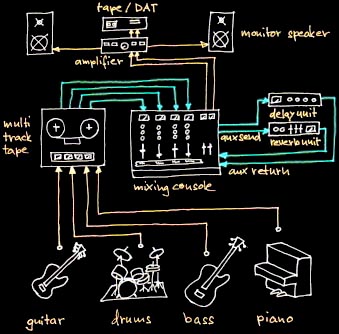Producing a traditional Dub Reggae track in 6 steps
This page will give you a basic idea of what producing Dub is about. Since Dub is an artform
which evolved from the recording techniques available in Jamaica back in the seventies the equipment
used in this example is from that period too.
Of course nowadays you can use modern equipment
which offers far more possibilities especially when it comes to editing and controlling
details of the production (hard disc recording, mixing automation, ..). It is felt by some
producers however that real dub must be mixed by hand in real time as a "direct-to-tape
mixing performance".
After getting an overview on this page you can find more information about individual aspects
of the recording process in the specialised scrolls.
- Get the following equipment:

- multitrack tape machine
- mixing console
- amplifier and speakers to monitor your music
- a second recording device to capture your final mix
- effect units: delay, reverb
- cables to connect everything
- instruments & players: drums, bass, guitar, keyboards, horns, percussion, vocals
- Record a song or at least a basic arrangement.
- Make sure each instrument or instrument group is recorded on an individual track of your tape.
- Start by making a basic mix: Set the levels and equalizing for each track
on the mixing desk so that all elements are well balanced. (This alone is an art in itself, but this site is about
Dub not about general recording techniques so we won't go into details here.)
- Run the song and switch on and off individual tracks during the song.
typical settings are:
- all tracks switched on
- just drums & bass
- all tracks except drums & bass
- Voices are usually only thrown into the mix occasionally.
- Use the different effects on the individual tracks.
typical techniques are:
- Connect the effects to the auxiliary sends
of your mixing desk. Thus you can apply an effect to a single track only.
- Set delay times to match the song speed
(use whole beat, half beat, tripplet timing..
very typical: one and a half beat)
- reverb or echo on the snare drum; not
everytime but once in a while
- Change the delay time during the song - this
leads to echoes bouncing up and down
in pitch (only on analog delay units).
- echo on the offbeat guitar: Open the aux send
slowly over 2 bars letting the echoes
accumulate until they start to overcrowd
the sound then switch off the offbeat track.
The delays will go on for a while and fade
out.
- Make sure the sound stays crisp: keep bass
and drums dominant; Don't open all aux sends
at once.
- Repeat the whole mix many times and listen
to the recorded dubs afterwards.
Then select the best version.
|


